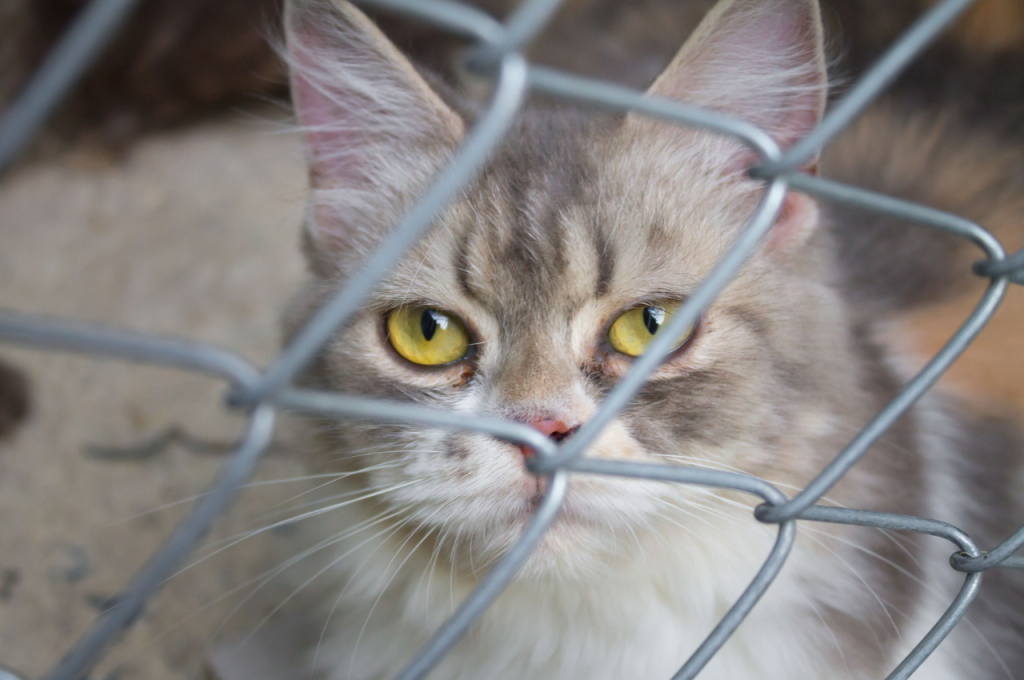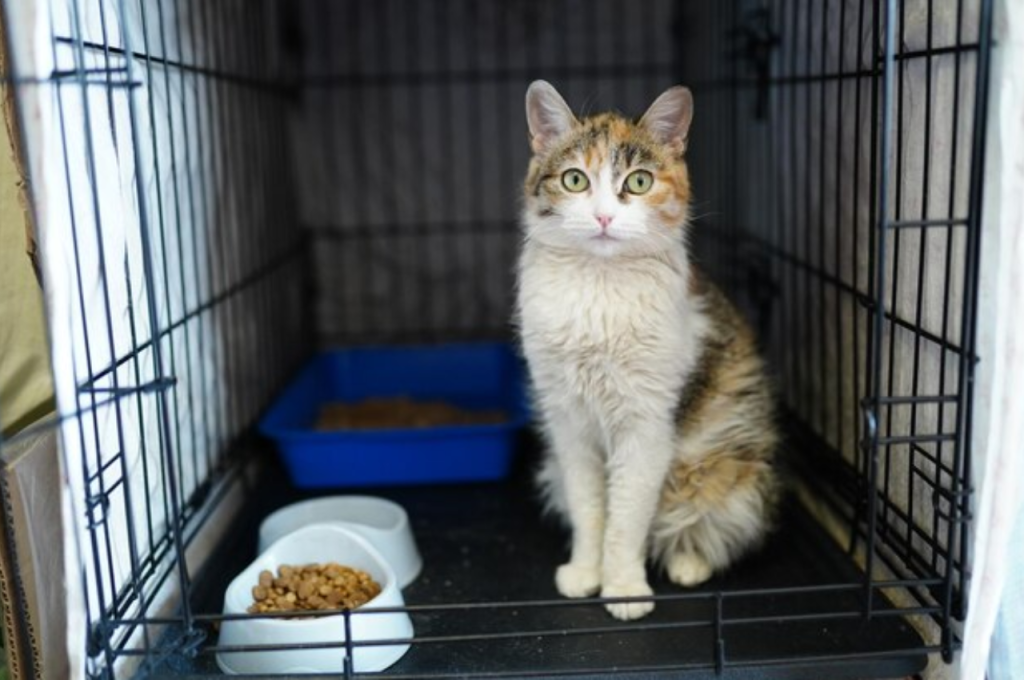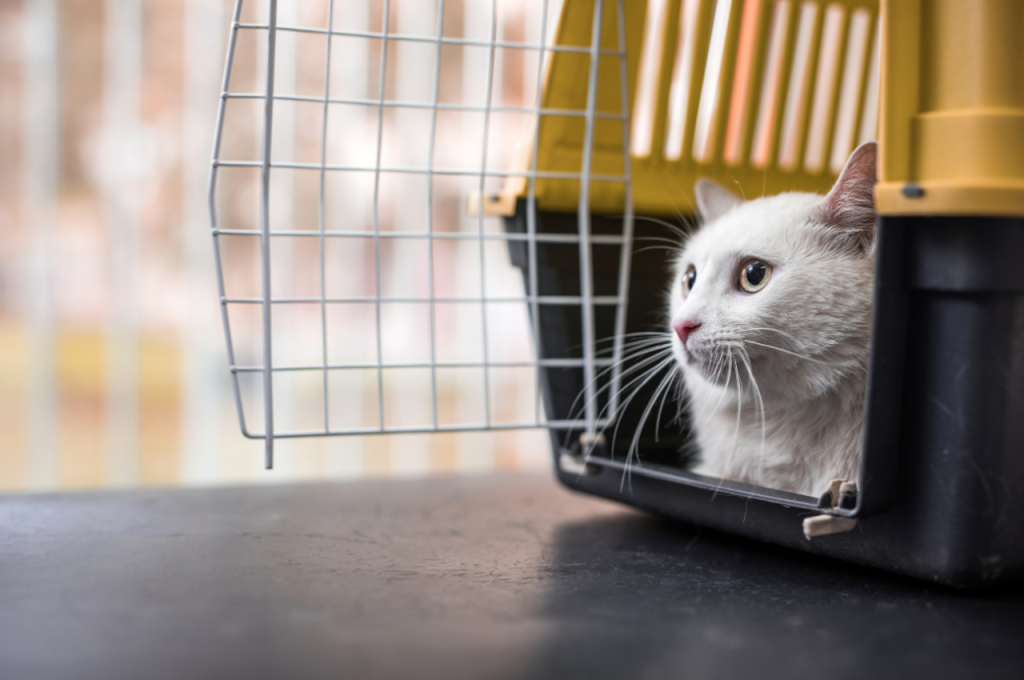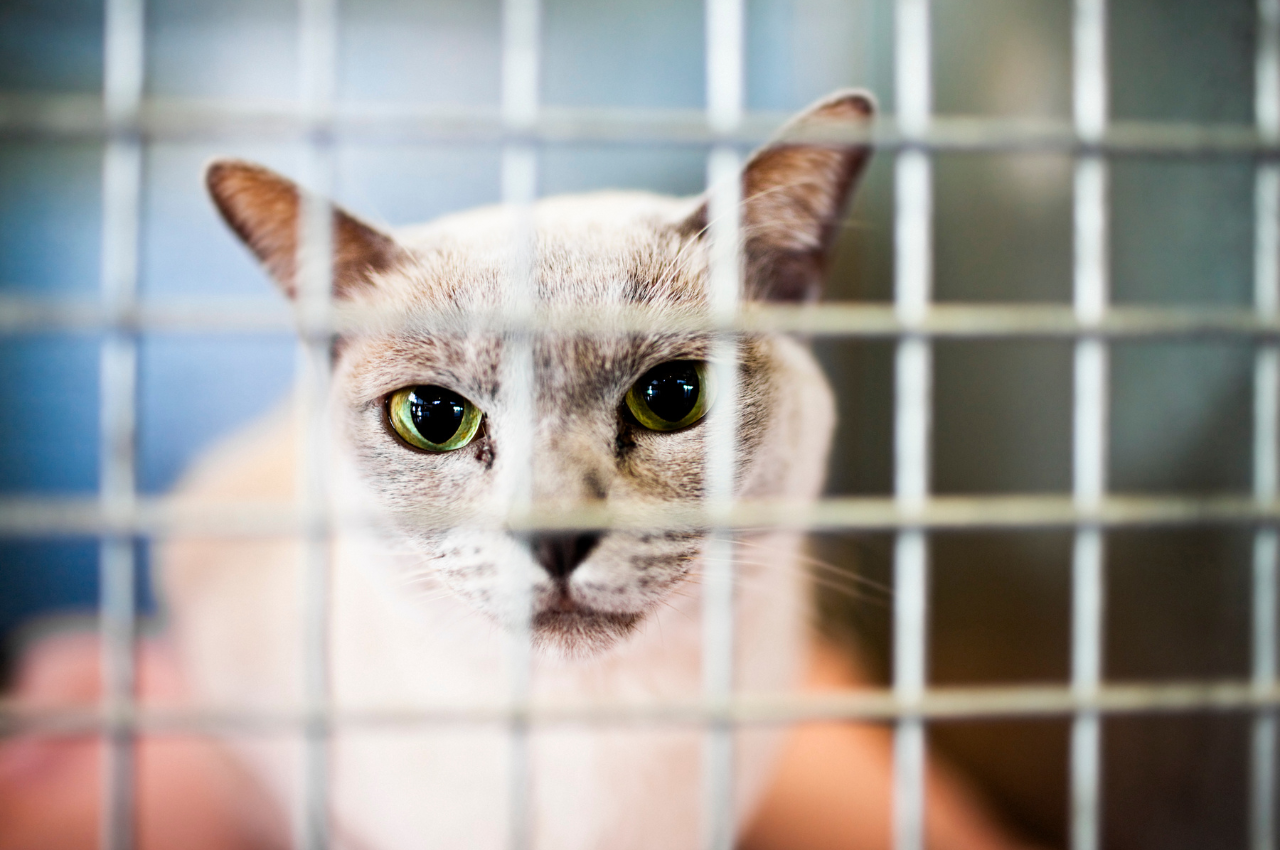To keep a cat calm in a cage, create a comfortable and stress-free environment. Start by placing familiar bedding or a favorite blanket inside to provide a sense of security. Adding a few comforting items, like a favorite toy, can also help the cat feel at ease.
Covering part of the cage with a cloth can reduce visual stimuli, making the space feel more private and secure. Make sure the cage is placed in a quiet area, away from loud noises or other pets. Additionally, you can use calming sprays or pheromones designed for cats to reduce anxiety. Offer soothing words and gentle petting when possible, but avoid forcing interaction, allowing the cat to adjust to the cage on its own terms.
Introduction To Feline Anxiety and Confinement
To keep a cat calm in a cage, provide a comfortable and secure environment with familiar items and soothing scents. Avoid sudden movements or loud noises that may startle the cat.

The Challenge Of Keeping Cats Calm
Keeping cats calm in a cage can be a challenging task, especially for felines prone to anxiety and stress. Cats are naturally independent animals, and confinement can trigger feelings of fear and vulnerability, leading to heightened anxiety levels.
Reasons For Caging A Cat
There are various reasons for caging a cat, such as transportation, medical recovery, or ensuring their safety in certain situations. When faced with such circumstances, it becomes essential to find effective strategies to keep the cat calm and comfortable within the confines of a cage.
Selecting The Right Cage
When selecting a cage for your cat, it’s crucial to consider their comfort and well-being. The right cage can help keep your cat calm and relaxed, even in stressful situations. Here are some key factors to keep in mind when choosing the right cage for your feline friend.
Size And Comfort Considerations
Ensure the cage is spacious enough for your cat to stand up, turn around, and stretch comfortably. A cozy and secure environment will help alleviate stress and anxiety. Provide soft bedding for added comfort, and consider the ease of cleaning to maintain a hygienic space for your cat.
Features Of A Stress-free Cage Design
- Secure door latches: To prevent accidental escapes and provide a sense of safety.
- Good ventilation: Ensure proper airflow to keep the cage fresh and free of odors.
- Visibility: Cats often feel more at ease when they can see their surroundings, so opt for a cage with clear sides.
- Quiet environment: Choose a location for the cage that minimizes noise and disturbances.
Creating A Comfortable Environment
Creating a comfortable environment for your cat in a cage is essential for keeping them calm and content. By focusing on aspects such as bedding, warmth, and familiar scents, you can help reduce your cat’s stress levels and ensure they feel safe and secure.
Importance Of Bedding And Warmth
Providing soft, comfortable bedding in the cage is crucial for your cat’s well-being. Cats are naturally drawn to warm and cozy spots, so incorporating warm blankets or cushions can help them feel more at ease. Additionally, ensuring the cage is placed away from drafts and cold areas will help maintain a comfortable temperature for your cat.
Using Familiar Scents
Introducing familiar scents into the cage can help your cat feel more relaxed. Placing items with familiar scents such as their bedding, toys, or clothing with your scent can provide a sense of security and comfort for your cat. These familiar scents can serve as a source of reassurance and stability, especially in unfamiliar environments.
The Role Of Diet and Hydration
Proper diet and hydration can play a significant role in keeping cats calm in a cage. It’s important to provide your cat with the right food and water to ensure that they stay comfortable and relaxed during their time in the cage. Additionally, make sure to clean their cage regularly to maintain a hygienic environment.
Choosing Calming Nutrients
A cat’s diet plays a crucial role in keeping them calm and relaxed while in a cage. When selecting food for your cat, consider choosing products that contain calming nutrients such as L-tryptophan, magnesium, and vitamin B6. These nutrients help to reduce stress and anxiety in cats, helping them to stay calm and relaxed in a cage. Additionally, foods that contain omega-3 fatty acids can also be helpful in reducing anxiety in cats.
Ensuring Access to Water
It’s important to make sure that your cat has access to fresh water at all times, especially when they are in a cage. Dehydration can cause stress and anxiety in cats, which can make them feel more anxious and agitated when in a cage. Consider using a water bowl that is designed for caged animals, as it will help to keep the water clean and fresh for longer periods. By choosing calming nutrients for your cat’s diet and ensuring they have access to fresh water, you can help keep your cat calm and relaxed while they are in a cage. This will make the experience less stressful for both you and your furry friend. Remember to always consult with your veterinarian before making any changes to your cat’s diet or lifestyle.
Incorporating Play and Stimulation
To keep a cat calm in a cage, incorporate play and stimulation. Provide interactive toys and puzzle feeders to keep them engaged. Additionally, use calming pheromone sprays or diffusers to create a soothing environment.
Toys and Entertainment
- Cats enjoy interactive toys such as feather wands and laser pointers.
- Providing toys that encourage natural hunting instincts helps keep them engaged.
Exercise Within The Cage
- Include a scratching post or cat tree for climbing and stretching.
- Rotate toys regularly to prevent boredom and encourage activity.
Training and Acclimatization Techniques
When it comes to keeping a cat calm in a cage, training and acclimatization techniques can be highly effective. With the right approach, cats can learn to associate the cage with positive experiences, reducing stress and anxiety.

Gradual Introduction To The Cage
One of the most important aspects of training your cat to be calm in a cage is to introduce the cage gradually. This can help your cat become accustomed to the cage and feel less fearful or anxious about being inside it.
- Start by placing the cage in a familiar area of your home, such as the living room or kitchen.
- Place treats and familiar toys inside the cage to encourage your cat to explore it.
- Over time, gradually move the treats and toys further inside the cage.
- When your cat is comfortable being inside the cage, start closing the door for short periods of time.
- Gradually increase the amount of time your cat spends in the cage with the door closed.
Positive Reinforcement Strategies
Positive reinforcement can be a powerful tool for helping your cat associate the cage with positive experiences. This can help to reduce stress and anxiety, making your cat more calm and relaxed in the cage.
- Use treats and praise to reward your cat for going into the cage.
- Offer treats and attention when your cat is calm and relaxed in the cage.
- Avoid punishing or scolding your cat for being anxious or fearful in the cage.
- Consider using calming products, such as pheromone sprays or diffusers, to help reduce anxiety.
With patience and consistency, these training and acclimatization techniques can help your cat feel more calm and comfortable in a cage. By using positive reinforcement and gradual introduction, you can help your cat associate the cage with positive experiences, reducing stress and anxiety.
Managing Noise and External Stimuli
To keep a cat calm in a cage, managing noise and external stimuli is crucial. Minimize loud sounds and place the cage in a quiet area to reduce stress. Additionally, covering the cage with a blanket can create a peaceful environment for the cat.
The Impact Of Sound
Loud noises can stress cats. Place the cage in a quiet area. Soft music or white noise can help.
Controlling Visual Stressors
Cover the cage partially. Limit exposure to unfamiliar sights. Provide familiar toys or blankets.
Utilizing Natural Remedies and Supplements
To keep a cat calm in a cage, natural remedies and supplements can be utilized. Try using pheromone diffusers, calming collars, or natural supplements like chamomile or valerian root to soothe your cat’s anxiety. Creating a comfortable and familiar environment inside the cage can also help reduce stress.
Herbal Solutions
Herbal remedies like chamomile and valerian can help calm anxious cats in cages.
Pheromones and Calming Collars
Pheromone sprays and calming collars release stress-relieving scents to relax cats.
When it comes to keeping a cat calm in a cage, utilizing natural remedies and supplements can be highly effective. Herbal solutions, such as chamomile and valerian, are known for their calming properties and can help alleviate stress and anxiety in cats. These natural remedies can be administered in the form of herbal teas or herbal supplements to promote relaxation.
Another approach is to use pheromone products and calming collars specifically designed to reduce a cat’s stress levels. Pheromone sprays emit calming scents that mimic those produced by mother cats to comfort their kittens while calming collars release pheromones that help create a sense of security and well-being for the cat.
Professional Care and Advice
Keeping a cat calm in a cage requires professional care and advice. With proper techniques and understanding, you can provide a stress-free environment for your feline friend. Discover effective ways to soothe your cat and make their time in the cage as comfortable as possible.
Cats are independent creatures and often do not like being confined in a cage. However, there are situations such as traveling, vet visits, or during recovery from illness or surgery when caging a cat is necessary. As a responsible pet owner, it is your duty to keep your cat calm and comfortable during these stressful times. In this article, we will discuss professional care and advice on how to keep a cat calm in a cage.
When To Consult A Vet
If you notice that your cat is exhibiting unusual behavior such as excessive meowing, aggression, or lethargy while in a cage, you should consult a vet immediately. These behaviors could be a sign of an underlying medical condition or pain that your cat is experiencing. Your vet can perform a thorough examination and offer appropriate treatment to ensure your cat’s well-being.
Behavioral Therapy For Anxious Cats
Cats can become anxious when they are caged, especially if they are not used to it. Behavioral therapy can help alleviate anxiety and make your cat feel more comfortable in a cage. Here are some tips for behavioral therapy:
- Introduce your cat to the cage gradually, starting with short periods and gradually increasing the duration.
- Place your cat’s favorite toys, blankets, and treats in the cage to make it a familiar and comfortable space.
- Use pheromone sprays or diffusers to calm your cat’s nerves.
- Play soothing music or leave a TV on to provide background noise.
- Avoid punishing or scolding your cat for exhibiting anxious behavior as this will only make the situation worse.
In conclusion, keeping a cat calm in a cage requires patience, understanding, and proper care. By following these professional care and advice tips, you can ensure that your cat is comfortable and stress-free while in a cage. Remember, a happy and healthy cat is a well-cared-for cat.
Ensuring Feline Well-being
Promote feline well-being by keeping your cat calm in a cage with cozy bedding, familiar toys, and soothing music. Cover the cage partially to create a secure environment and ensure regular breaks for exercise and human interaction, reducing stress levels.

Monitoring Stress Levels
- Observe cat behavior, body language, and vocalizations.
- Use stress indicators like dilated pupils and excessive grooming.
- Seek veterinary advice if stress signs persist.
Long-term Strategies For A Happy, Calm Cat
- Provide adequate space, enrichment, and hiding spots.
- Establish routine feeding, play, and grooming schedules.
- Ensure regular vet check-ups and vaccinations.
Conclusion
Keeping your cat calm in a cage is crucial for their well-being. By following the tips mentioned in this blog post, such as providing comfort items and ensuring proper ventilation, you can make the experience less stressful for your feline friend.
